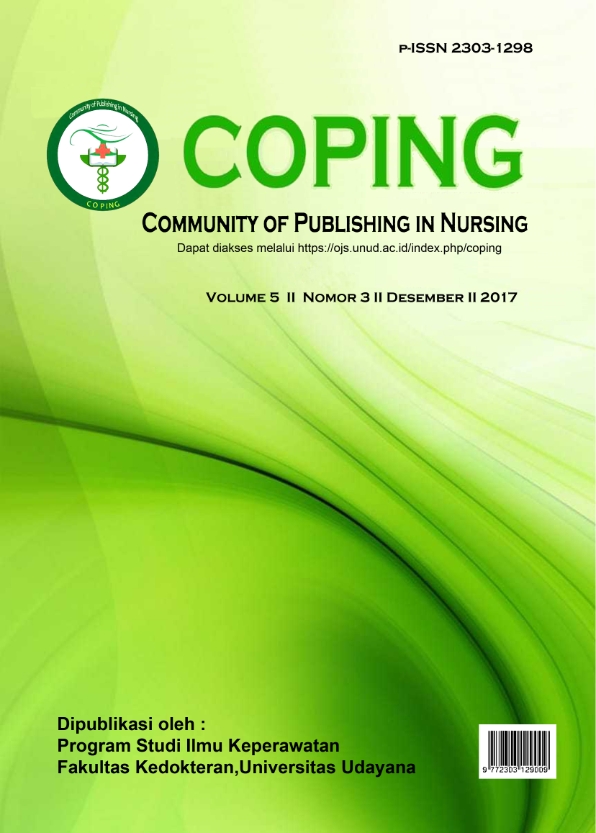PENGARUH LATIHAN ISOMETRIK TERHADAP TEKANAN DARAH PASIEN HIPERTENSI
Abstract
Hipertensi adalah tekanan darah tinggi persisten yang memiliki lebih dari 140/90 mmHg. Salah satu latihan fisik yang dapat bermanfaat untuk mengurangi tekanan darah adalah latihan isometrik. Tujuan penelitian ini adalah untuk mengetahui pengaruh latihan isometrik terhadap tekanan darah pasien hipertensi. Penelitian ini menggunakan desain quasi-eksperimental menggunakan pretest-posttest dengan kelompok kontrol dari 33 sampel yang telah dipilih dengan metode purposive sampling. Pengumpulan data dilakukan dengan pengukuran langsung pada tekanan darah dan dilakukan beberapa wawancara untuk mendapatkan karakteristik sampel. Hasil penelitian ini pada 17 sampel kelompok kontrol tidak menunjukkan penurunan tekanan darah yang signifikan pada pretest dan posttest, sedangkan kelompok lain dengan 16 sampel menunjukkan penurunan tekanan darah yang signifikan. Hasil penelitian ini juga menunjukkan perbedaan signifikan tekanan darah posttest pada kedua kelompok. Berdasarkan uji-t sampel independen, perbedaan ini signifikan secara statistik dengan tingkat signifikansi p = 0,000 (? <0,05). Berdasarkan hasil tersebut, disarankan kepada perawat untuk mempromosikan manajemen hipertensi melalui perubahan gaya hidup, terutama aktivitas fisik yang dapat dilakukan dengan latihan isometrik sebagai latihan harian.
Kata kunci: tekanan darah, hipertensi, latihan isometrik
ABSTRACT
Hypertension is a persistent high blood pressure which has more than 140/90 mmHg. One of the physical exercises that can be useful to reduce blood pressure is isometric exercise. Goal of this research is to determine the effect of isometric exercise on blood pressure of hypertensive patient. This research utilizes a quasi-experimental design using pretest-posttest with control group of 33 samples that have been selected by purposive sampling method. Data collection is performed by a direct measurement on blood pressure and done some interview to get characteristic of the samples. The results of this research on those 17 samples of control group did not show any significant reduction in blood pressure on pretest and posttest, whereas other group with 16 samples showed significant reduction in blood pressure. The results of this research also showed significant difference posttest blood pressure in both groups. Based on the independent sample t-test, this difference is statistically significant with significance level of p=0.000 (?<0.05). Based on those results, it is suggested to nurses to promote the management of hypertension through lifestyle changing, especially physical activity that can be performed with isometric exercise as daily exercise.
Keywords: blood pressure, hypertension, isometric exercise
Downloads
References
Corwin, E. J. (2009). Handbook of pathophysiology. Edisi 3. Diterjemahkan oleh Nike Budhi Subekti. Jakarta: Penerbit Buku Kedokteran EGC.
Debra, J.C, Dieberg, G., Hess, N.C., Millar, P.J., Smart, N.A. (2014) Isometric exercise training for blood pressure management: A systematic review and meta-analysis. ProQuest public health. Page 327. 83,3
Devereux, G.R., Wiles, J.D., Swaine, I.L. (2010) Reductions in resting blood pressure after 4 weeks of isometric exercise training. Springer eur j appl physiol. 109: 601-606. DOI 10.1007/s00421-010-1394-x
Guyton, A.C., Hall, J.E. (2006) Buku ajar fisologi kedokteran. Edisi 11. Diterjemahkan oleh Irawati dkk. Jakarta: Penerbit Buku Kedokteran EGC.
Hinkle, J.L., Cheever, K.H. (2013). Brunner & Suddarth’s textbook of medical surgical nursing 13thedition. Philadelphia: Lippincott Williams & Wilkins Pty, Limited.
James, et al. (2014) 2014 Evidence-based guideline for the management of high high blood pressure in adult: Report from the panel members appointed to eighth joint national comitte (JNC 8). The Journal of the American Medical Association. 2014; 311(5):507-520
Kabo, P. (2008) Mengungkap pengobatan penyakit jantung koroner. Jakarta: Gramedia Pustaka Utama.
Kenchaiah S, Sesso HD, Gaziano JM. (2009) Body mass index and vigorous physical activity and the risk of heart failure among men. Circulation;119:44-52.
Kisner, C. & Colby, L.A. (2007). Therapeutic exercise: Foundation and teciques. Philadelphia: F.A. Davis Company.
Mancia, et.al. (2013) ESH and ESC guidelines. Journal of hypertension. 31:1281–1357
McGowan, et.al. (2007) Isometric handgrip training improves local flow-mediated dialation in medical hypertensives. Eur j appl physiol springer. 99:227-234. DOI 10.1007/s00421-006-0337-z
Millar, P.J., MacDonald, M.J., Bray, S.R., McCartney, N. (2009) Isometric handgrip exercise improve acute neurocardiac regulation. Eur j appl physiol. 107:509-515. DOI 10.1007/s00421-009-1142-2
Millar, P.J., McGowan, C.L., Cornelissen, V.A., Araujo, C.G., Swaine, I.L. (2013). Evidence for the role of isometric exercise training in reducing blood pressure: Potential mechanism and future directions. Springer international publishing switzerland. Sport Med. DOI 10.1007/s40279-013-0118-x.
NICE Clinical Guideline 127. (2011). Hypertension (clinical management of primary hypertension in adults). United Kingdom: National Institute for Health and Care Excellence (NICE).
Owen, A., Wiles, J., Swaine, I. (2010) Effect of isometric exercise on resting blood pressure: a meta-analysis. Journal of human hypertension. 24, 796-800. 0950-9240/I0
Peters, P.G., Alessio, H. M., Hagerman, A. E., Ashton, T., Nagy, S., Wiley, R.L. (2006). Short-term isometric exercise reduces systolic blood pressure in hypertension adults: possible role of reactive oxygen species. International journal of cardiology 110(2):199-205.
Sari, R. K., & Livana, P. H. (2016). FAKTOR-FAKTOR YANG MEMPENGARUHI HIPERTENSI. Jurnal Ilmiah permas: Jurnal Ilmiah Stikes Kendal, 6(1), 1-10.
Tomey, A.M. & Alligood, M. (2006). Nursing theorist and their work. Australia: Elsevier Health Science
Weber, M.A., et,al. (2014). Clinical practice guidelines for the management of hypertension in the community: A statement by the american society of hypertension and the international society of hypertension. The journal of clinical hypertension. DOI: 10.1111.jch.12237.
Weir, M. R. (2005). Hypertension. United States America: Versa Press.







